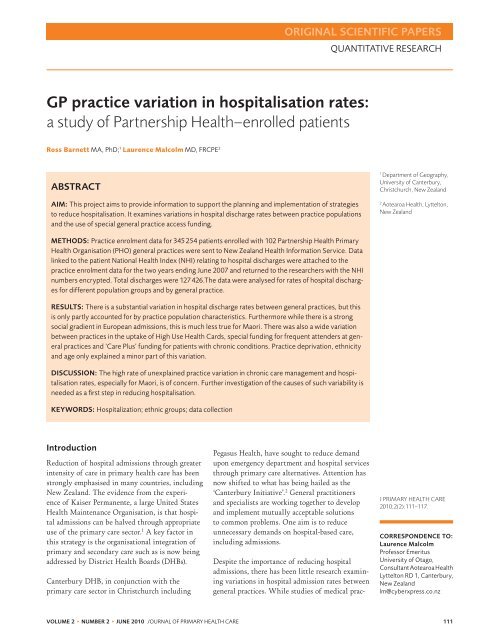entire issue - The Royal New Zealand College of General Practitioners
entire issue - The Royal New Zealand College of General Practitioners
entire issue - The Royal New Zealand College of General Practitioners
You also want an ePaper? Increase the reach of your titles
YUMPU automatically turns print PDFs into web optimized ePapers that Google loves.
ORIGINAL SCIENTIFIC PAPErS<br />
quantitative research<br />
GP practice variation in hospitalisation rates:<br />
a study <strong>of</strong> Partnership Health–enrolled patients<br />
Ross Barnett MA, PhD; 1 Laurence Malcolm MD, FRCPE 2<br />
ABSTRACT<br />
Aim: This project aims to provide information to support the planning and implementation <strong>of</strong> strategies<br />
to reduce hospitalisation. It examines variations in hospital discharge rates between practice populations<br />
and the use <strong>of</strong> special general practice access funding.<br />
1<br />
Department <strong>of</strong> Geography,<br />
University <strong>of</strong> Canterbury,<br />
Christchurch, <strong>New</strong> <strong>Zealand</strong><br />
2<br />
Aotearoa Health, Lyttelton,<br />
<strong>New</strong> <strong>Zealand</strong><br />
Methods: Practice enrolment data for 345 254 patients enrolled with 102 Partnership Health Primary<br />
Health Organisation (PHO) general practices were sent to <strong>New</strong> <strong>Zealand</strong> Health Information Service. Data<br />
linked to the patient National Health Index (NHI) relating to hospital discharges were attached to the<br />
practice enrolment data for the two years ending June 2007 and returned to the researchers with the NHI<br />
numbers encrypted. Total discharges were 127 426.<strong>The</strong> data were analysed for rates <strong>of</strong> hospital discharges<br />
for different population groups and by general practice.<br />
Results: <strong>The</strong>re is a substantial variation in hospital discharge rates between general practices, but this<br />
is only partly accounted for by practice population characteristics. Furthermore while there is a strong<br />
social gradient in European admissions, this is much less true for Maori. <strong>The</strong>re was also a wide variation<br />
between practices in the uptake <strong>of</strong> High Use Health Cards, special funding for frequent attenders at general<br />
practices and ‘Care Plus’ funding for patients with chronic conditions. Practice deprivation, ethnicity<br />
and age only explained a minor part <strong>of</strong> this variation.<br />
Discussion: <strong>The</strong> high rate <strong>of</strong> unexplained practice variation in chronic care management and hospitalisation<br />
rates, especially for Maori, is <strong>of</strong> concern. Further investigation <strong>of</strong> the causes <strong>of</strong> such variability is<br />
needed as a first step in reducing hospitalisation.<br />
KEYWORDS: Hospitalization; ethnic groups; data collection<br />
Introduction<br />
Reduction <strong>of</strong> hospital admissions through greater<br />
intensity <strong>of</strong> care in primary health care has been<br />
strongly emphasised in many countries, including<br />
<strong>New</strong> <strong>Zealand</strong>. <strong>The</strong> evidence from the experience<br />
<strong>of</strong> Kaiser Permanente, a large United States<br />
Health Maintenance Organisation, is that hospital<br />
admissions can be halved through appropriate<br />
use <strong>of</strong> the primary care sector. 1 A key factor in<br />
this strategy is the organisational integration <strong>of</strong><br />
primary and secondary care such as is now being<br />
addressed by District Health Boards (DHBs).<br />
Canterbury DHB, in conjunction with the<br />
primary care sector in Christchurch including<br />
Pegasus Health, have sought to reduce demand<br />
upon emergency department and hospital services<br />
through primary care alternatives. Attention has<br />
now shifted to what has being hailed as the<br />
‘Canterbury Initiative’. 2 <strong>General</strong> practitioners<br />
and specialists are working together to develop<br />
and implement mutually acceptable solutions<br />
to common problems. One aim is to reduce<br />
unnecessary demands on hospital-based care,<br />
including admissions.<br />
Despite the importance <strong>of</strong> reducing hospital<br />
admissions, there has been little research examining<br />
variations in hospital admission rates between<br />
general practices. While studies <strong>of</strong> medical prac-<br />
J PRIMARY HEALTH CARE<br />
2010;2(2):111–117.<br />
CORRESPONDENCE TO:<br />
Laurence Malcolm<br />
Pr<strong>of</strong>essor Emeritus<br />
University <strong>of</strong> Otago,<br />
Consultant Aotearoa Health<br />
Lyttelton RD 1, Canterbury,<br />
<strong>New</strong> <strong>Zealand</strong><br />
lm@cyberxpress.co.nz<br />
VOLUME 2 • NUMBER 2 • JUNE 2010 J OURNAL OF PRIMARY HEALTH CARE 111

















